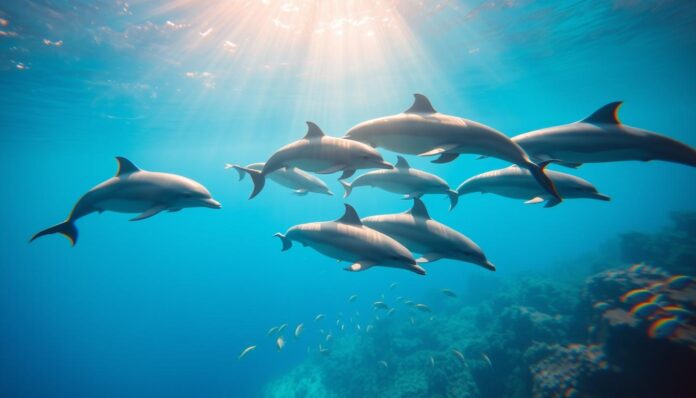Did you know over 70% of dolphin encounters are unforgettable? Scuba diving with dolphins lets you connect with these amazing creatures in their home. It’s a chance to see the underwater world and meet marine mammals up close.
Dolphin diving trips last from 20 to 45 minutes. They have groups of 4 to 6 people with 1 to 2 dolphins. It’s a rare chance to see and interact with the ocean’s smartest animals. You can dive with dolphins in places like Cozumel, Mexico, or the Caribbean.
Places like the Dolphin Academy make sure these dives are safe and fun. You need to be at least 14 and pass a health check. Tours cost about $189.00 and last 3+ hours. They mix adventure, learning, and excitement.
Key Takeaways – Diving with Dolphins
- Dolphin encounters are considered once-in-a-lifetime experiences
- Tours typically last 3+ hours with groups of 4-6 people
- Minimum age requirement is 14 years old
- Medical screening is required for all participants
- Experiences combine marine exploration with wildlife interaction
What to Expect When Scuba Diving with Dolphins
Swimming with dolphins is an amazing underwater adventure. It connects humans with nature’s smartest sea creatures. Dolphin swim tours let you see these amazing animals in their home, making unforgettable memories.
For diving fans, swimming with dolphins is a magical journey. The sea is a special place for these amazing meetings. Dolphins show off their fun social ways here.
The Dolphin Encounter Experience
On dolphin swim tours, you’ll have many cool moments with these sea stars. Dolphins often:
- Move gracefully underwater
- Do fun spins and flips
- Chat with each other in clicks and whistles
- Curiously come close to divers
Interactions with Dolphins in Their Natural Habitat
Meeting dolphins in their home needs respect and knowing. These smart animals talk to each other in special ways. They often show they’re there even if you can’t see them right away.
“Observe, but never disturb” is the golden rule of marine wildlife interactions.
Safety Precautions to Consider
Safe dolphin diving means following some key rules:
- Keep a safe distance
- Don’t make sudden moves
- Never try to touch or chase them
- Always listen to your guide
| Diving Parameter | Recommended Guidelines |
|---|---|
| Maximum Depth | 20-30 meters |
| Dive Duration | 30-45 minutes |
| Water Temperature | 22-26°C |
Safe diving keeps both people and dolphins safe. It makes for a great underwater experience that cares for the sea.
The Best Locations for Dolphin Diving Adventures
Going on dolphin adventure tours is a great way to see the marine world. You get to see dolphins in their natural home. Each place offers a special experience for watching dolphins and diving.
Finding the best spot for dolphin diving needs some thought. You can choose from tropical waters to marine sanctuaries. The world has many amazing places for those who love the sea.
Top Global Destinations for Dolphin Encounters
Asia:
- Maldives: The Maldives archipelago is renowned for its stunning coral reefs and abundant marine life. Here, encounters with spinner dolphins are common, with these playful creatures often seen leaping and spinning through the clear turquoise waters.
- Red Sea, Egypt: The Red Sea is home to vibrant coral reefs teeming with marine life. Alongside dolphins, divers can encounter species like bottlenose dolphins, Risso’s dolphins, and even the charismatic and rare dugongs.
- Mozambique: The warm waters of Mozambique provide opportunities for encounters with dolphins, including the energetic and acrobatic spinner dolphins. The Bazaruto Archipelago and Inhambane region are particularly popular for dolphin dives.
- Zanzibar, Tanzania: Zanzibar offers a combination of stunning dive sites and the chance to encounter dolphins, including bottlenose dolphins and humpback dolphins. The island’s crystal-clear waters provide an ideal backdrop for underwater adventures.
Caribbean:
- Bahamas: The Bahamas is home to the famous dolphin hotspot known as Dolphin Cay. Here, divers have the opportunity to engage in interactive encounters with dolphins in a controlled and responsible environment.
- Turks and Caicos Islands: With its turquoise waters and thriving marine ecosystems, the Turks and Caicos Islands offer memorable encounters with Atlantic spotted dolphins, bottlenose dolphins, and occasionally even humpback dolphins.
- Honduras: The Bay Islands of Honduras, including Roatán and Utila, offer fantastic diving opportunities and encounters with various dolphin species. Divers can spot Atlantic bottlenose dolphins, spotted dolphins, and sometimes even the elusive and playful rough-toothed dolphins.
- Belize: Belize’s barrier reef, a UNESCO World Heritage Site, is home to an abundance of marine life, including dolphins. Divers can encounter species such as bottlenose dolphins, spotted dolphins, and the endangered Antillean manatee.
- Azores, Portugal: The Azores archipelago in the Atlantic Ocean provides incredible encounters with several dolphin species, including common dolphins, bottlenose dolphins, and Risso’s dolphins. The waters around the islands are a haven for marine biodiversity.
- Canary Islands, Spain: The Canary Islands offer divers the chance to encounter a variety of dolphin species, including Atlantic spotted dolphins, bottlenose dolphins, and short-finned pilot whales. These charismatic creatures are often found in the waters surrounding the islands.
- New Zealand: New Zealand’s coastal waters are home to several dolphin species, including the common dolphin and dusky dolphin. The Bay of Islands and Marlborough Sounds are popular areas for dolphin encounters.
- Fiji: Fiji’s warm waters and abundant coral reefs are not only beautiful but also attract various dolphin species. Divers can encounter spinner dolphins, bottlenose dolphins, and even the majestic humpback dolphins during their underwater adventures.
- Hawaii, USA: Hawaii’s crystal-clear waters are a haven for marine life, including spinner dolphins and bottlenose dolphins. Several dive sites around the islands offer opportunities for dolphin encounters.
- Florida, USA: In the waters off the coast of Florida, divers can encounter Atlantic spotted dolphins, bottlenose dolphins, and even the gentle manatees. The warm Gulf Stream provides ideal conditions for encounters with these charismatic marine creatures.
- Galapagos Islands, Ecuador: The Galapagos Islands are famous for their unique and diverse wildlife, and dolphins are no exception. Here, divers can encounter species such as bottlenose dolphins, spinner dolphins, and even the elusive and endangered Galapagos fur seals.
- Fernando de Noronha, Brazil: This archipelago off the northeastern coast of Brazil offers incredible marine biodiversity. Divers can encounter spinner dolphins, rough-toothed dolphins, and even the mighty orcas in these waters.
These destinations offer unforgettable opportunities to dive alongside dolphins and witness their natural behavior in some of the world’s most breathtaking underwater environments. Always remember to engage in responsible and ethical interactions, respecting the well-being of these remarkable marine creatures and their habitats.
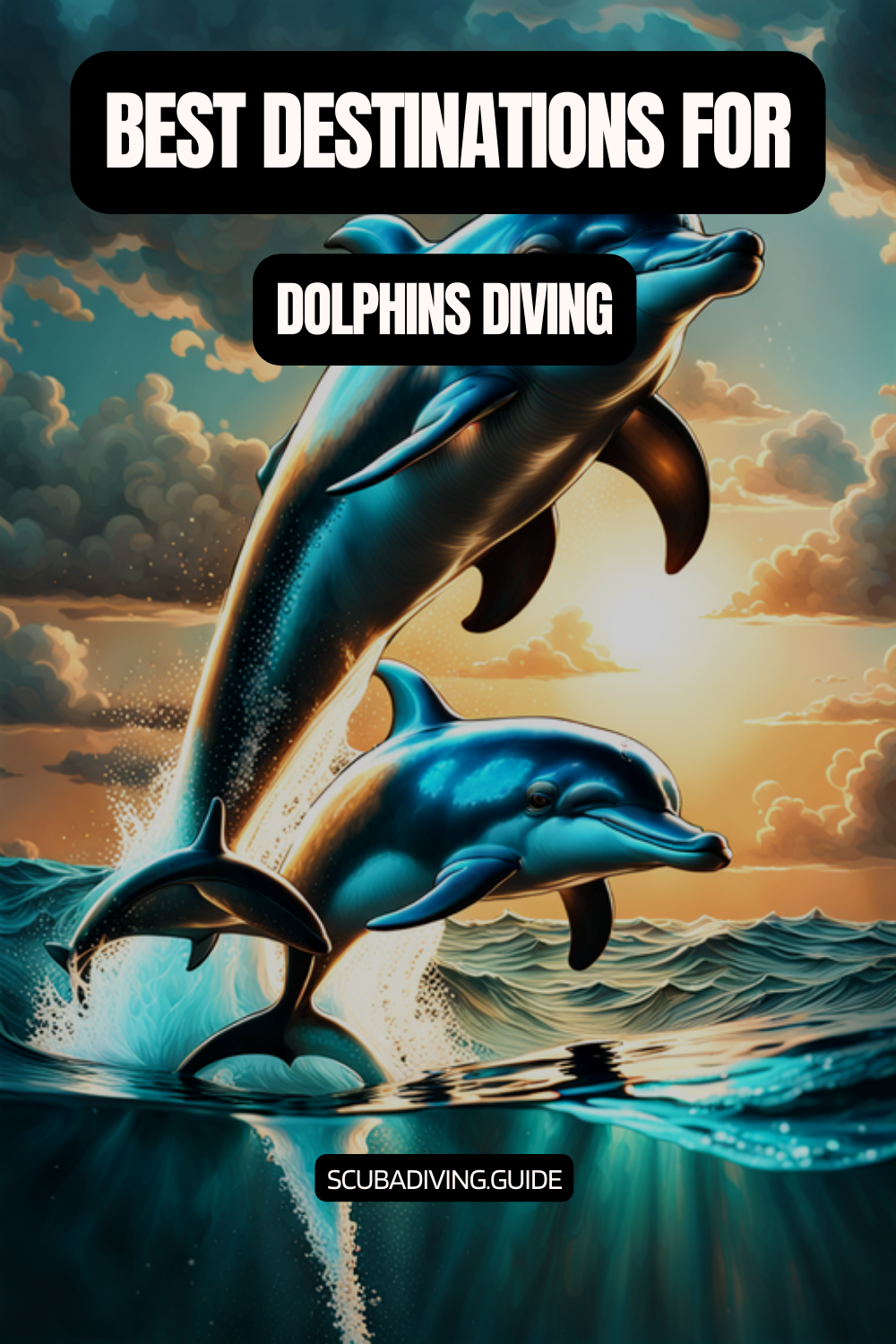
Factors to Consider for Dolphin Diving Locations
| Location | Dolphin Species | Best Season |
|---|---|---|
| Bimini, Bahamas | Wild dolphin expeditions | Summer months |
| Hawaii | Spinner, bottlenose, spotted | Year-round |
| Raja Ampat, Indonesia | Multiple species | October to April |
“The ocean is a magical place where dolphins remind us of the incredible diversity of marine life.”
When planning dolphin watching, look into local sea conditions and the reputation of tour operators. Also, consider the best time to go. Each place gives a different view of these smart sea creatures.
Planning Your Dolphin Adventure
Get ready for your dolphin diving trip by thinking about:
- Water temperature and how clear it is
- Local sea protection rules
- What diving level you need
- The right gear for meeting dolphins
The Environmental Benefits of Diving with Dolphins
Dolphin eco-tourism is more than just fun. It helps protect marine life and the ocean. By diving responsibly, you help keep dolphins and their homes safe.
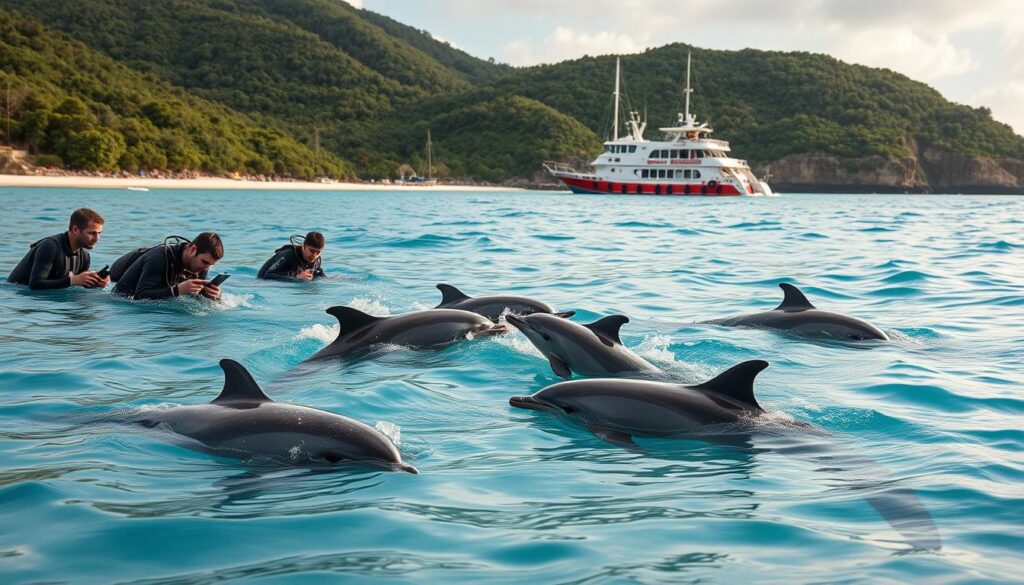
Marine research and conservation get a big boost from dolphin tourism. Here’s what it shows:
- 65% of participants show increased awareness of marine conservation
- Dolphin encounters reduce stress levels by up to 40%
- Ethical dive operators see a 50% increase in repeat customers
Promoting Marine Conservation
Responsible dolphin tourism is key to ocean protection. It helps scientists study dolphins and their homes. Climate change is a big threat, with 70% of US marine mammals facing warmer waters.
Supporting Dolphin Research Efforts
“Every dolphin encounter is an opportunity to learn and protect these remarkable creatures.” – Marine Biologist Research Team
Studies show dolphins face big environmental challenges:
| Environmental Challenge | Impact on Dolphins |
|---|---|
| Ocean Temperature Rise | Decreased survival rates and reproductive challenges |
| Algal Blooms | Toxic environments causing widespread dolphin mortality |
| Habitat Disruption | Forced migration and breeding area changes |
By choosing responsible dolphin tourism, you help conservation efforts. Your dive supports research and raises awareness. It’s a way to protect these amazing creatures.
Preparing for Your Dolphin Scuba Diving Trip
Going on a scuba diving with dolphins trip needs careful planning and the right attitude. Whether it’s a dolphin safari or exploring the sea, knowing the basics can make your trip amazing.
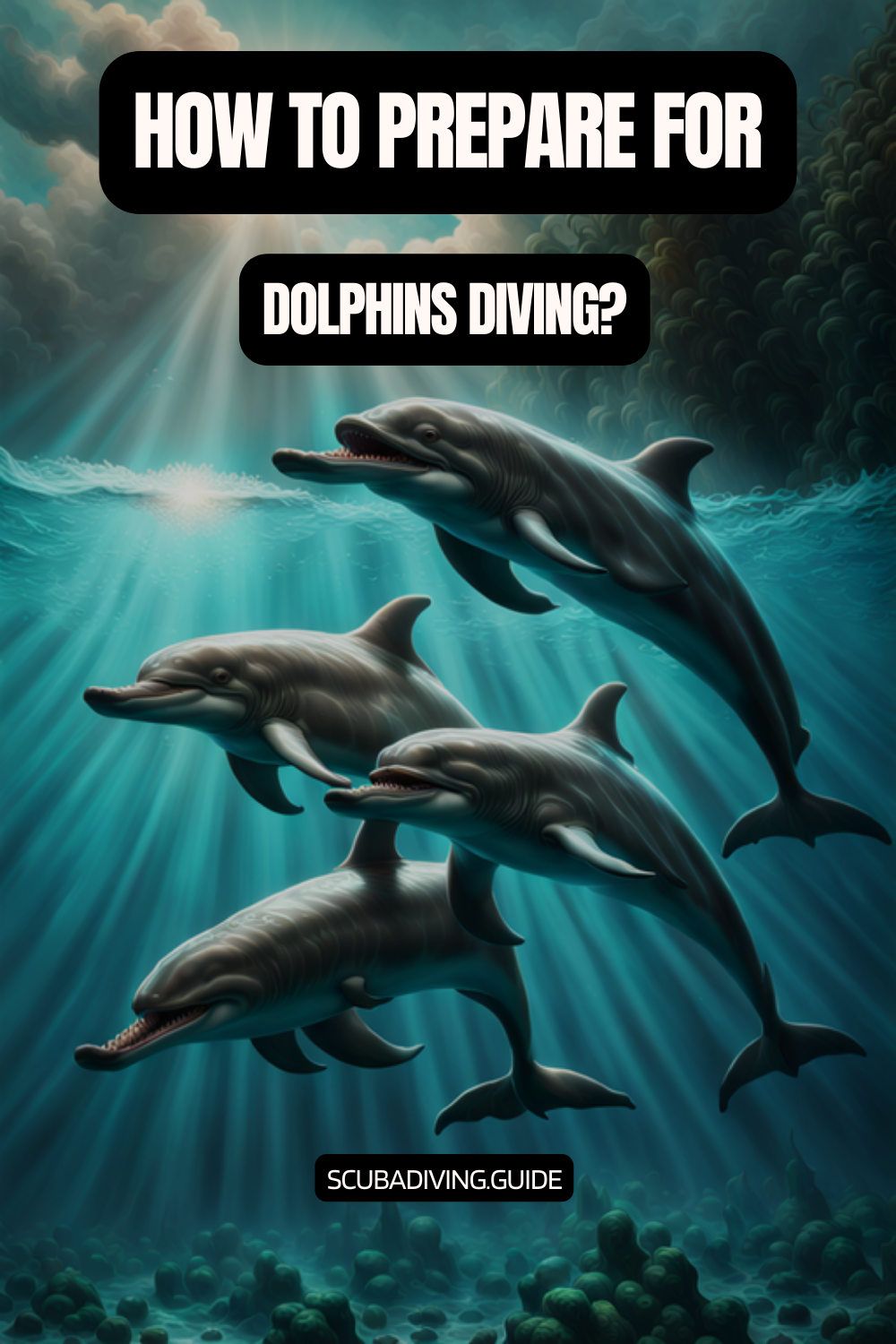
Essential Gear and Equipment
Choosing the right gear is key for a great dolphin encounter. Your scuba diving list should include:
- Wetsuit with UV protection
- Reef-friendly sunscreen
- Mask and snorkel
- Underwater camera
- Dive computer
Understanding Scuba Diving Certification Levels
Different dolphin experiences need different diving skills. Here’s a quick guide to what you need:
| Program | Certification Level | Age Requirement | Price |
|---|---|---|---|
| Dolphin Encounter | No certification needed | 3+ years | $89 USD |
| Dolphin Swim and Snorkel | Basic snorkeling experience | 8+ years | $129 USD |
| Dolphin Action Swim | Intermediate diving skills | 5+ years | $139 USD |
What to Pack for Your Adventure
Getting ready for a dolphin safari is more than just diving gear. Pack light but smart. Bring:
- Quick-dry towels
- Waterproof bag
- Extra swimwear
- Hydration and snacks
- Motion sickness medication
“The magic of scuba diving with dolphins isn’t in the equipment, but in the connection you create underwater.” – Marine Biologist
The best time for dolphin trips is from February to August. The seas are calm, and the weather is warm. Book early, from December to April, to get a spot on this amazing sea adventure.
Understanding Dolphin Behavior Underwater
Diving into the world of marine wildlife interactions shows us the amazing social lives of dolphins. These smart sea creatures form complex social groups. This fascinates both marine fans and scientists.
Social Structures Within Dolphin Pods
Dolphins live in groups called pods. These groups show amazing communication and bonding. Their social life is full of:
- Synchronized swimming patterns
- Complex communication through clicks and whistles
- Tight family bonds maintained through cooperative activities
“Dolphins are among the most intelligent and socially sophisticated creatures in the marine world.”
Communication and Playfulness of Dolphins
Dolphin encounters give us a peek into their playful side. These marine wildlife interactions show us:
- Using seaweed for play during relaxed moments
- Performing spy hopping to gather environmental information
- Engaging in acrobatic jumps and synchronized movements
| Dolphin Behavior | Significance |
|---|---|
| Tail Lob | Potential sign of agitation |
| Synchronized Swimming | Reinforces social bonds |
| Brain Hemisphere Sleeping | Maintains environmental awareness |
Divers should keep a safe distance of 3-5 meters. This ensures comfortable dolphin encounters. Knowing their behavior helps us avoid disturbing them and creates special marine wildlife interactions.
The Role of Accredited Dive Operators
Choosing the right dive operator is key for a great dolphin tour. Good operators ensure a safe and fun experience for everyone. They also protect marine life.
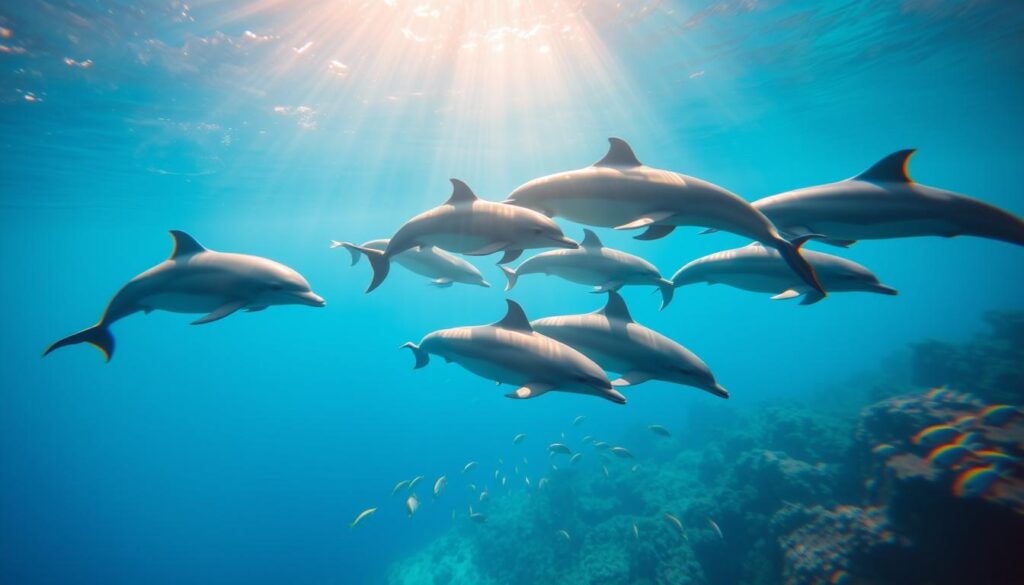
When planning your dolphin tour, do your homework. Look for operators who care about marine life and follow safety rules.
Identifying Responsible Dive Operators
Find operators who are serious about marine conservation. Look for these signs:
- Certified marine conservation credentials
- Small group size policies
- Professional, experienced guides
- Clear safety guidelines
- Commitment to minimal environmental impact
Critical Questions to Ask Before Booking
Ask these questions before booking your dolphin tour:
- What are your marine interaction guidelines?
- How do you protect dolphin habitats?
- What safety measures do you implement?
- Can you provide recent client testimonials?
- What is your marine conservation track record?
“Responsible diving is about respect – for marine life, the environment, and fellow divers.”
Operator Credentials Comparison
| Operator Criteria | Recommended Standard | Importance Level |
|---|---|---|
| Marine Conservation Certification | Active Membership | High |
| Guide Experience | 5+ Years | Critical |
| Group Size | Maximum 6-8 Divers | Medium |
| Safety Protocols | Comprehensive Written Guidelines | Extremely High |
Choosing the right dive operator makes your dolphin swim tour unforgettable. It’s more than just an adventure; it’s a responsible marine experience.
Unique Experiences Beyond Scuba Diving
Exploring marine wildlife doesn’t always need scuba diving. Dolphin encounters offer exciting ways to connect with these smart sea creatures. They cater to different skill levels and preferences.
Snorkeling with Dolphins: A Breathtaking Alternative
Snorkeling with dolphins is a thrilling experience for ocean lovers. It’s different from scuba diving because you get closer to these playful creatures in their home.
- Requires minimal equipment
- Suitable for beginners
- Offers intimate marine encounters
Dolphin Watching vs. Diving Experiences
Dolphin watching and snorkeling with dolphins give different experiences. Dolphin watching lets you see them from afar. Snorkeling with dolphins brings you up close.
| Dolphin Watching | Snorkeling with Dolphins |
|---|---|
| Observational experience | Direct marine interaction |
| Limited engagement | Close-proximity encounters |
| Typically from boat | In water with dolphins |
“The magic of dolphins isn’t just in seeing them, but in experiencing their world firsthand.” – Marine Wildlife Expert
For those looking for snorkeling with dolphins, Truk Lagoon is a great spot. It’s home to spinner, bottlenose, and rough-toothed dolphins. Here, you can have unforgettable dolphin watching moments.
Safety is key during these marine adventures. Keeping a respectful distance and following guides ensures safety for both humans and dolphins. This way, you can have memorable and responsible wildlife encounters.
Capturing Memories: Photography Tips
Documenting dolphin encounters needs skill, patience, and respect. Underwater photography is special, with its own challenges and rules.
Best Practices for Underwater Photography
Choosing the right gear is key for amazing shots. Experts suggest:
- GoPro for affordable underwater shots
- Olympus TG-6 for waterproof performance
- Wide-angle lenses for dolphin photography
Lighting is vital in underwater photos. Natural light is great, but knowing how water affects it is important.
Ethical Considerations for Dolphin Photography
“Respect the ocean’s inhabitants more than your desire for the perfect shot.”
Responsible dolphin photography puts animal welfare first. Important rules include:
- Maintain safe distance from marine wildlife
- Avoid using flash photography
- Never pursue or touch dolphins
| Camera Type | Cost Range | Recommended Use |
|---|---|---|
| GoPro | $200-$400 | Beginner underwater photography |
| Olympus TG-6 | $400-$600 | Advanced waterproof shooting |
| Nikon D7200 with Housing | $1500-$3000 | Professional marine photography |
Citizen science programs now enable photographers to contribute valuable marine research through their dolphin encounter documentation.
Share Your Adventure: Community and Resources
After diving into the world of dolphin eco-tourism, connecting with others is a big part of the fun. Sites like Marine Conservation Network and Dive Buddies are great for sharing stories, swapping tips, and meeting marine lovers from around the world.
PADI AWARE Foundation is a key player in marine conservation. With over 30 years of work and support for 50 projects in 17 countries, they’re a big force for ocean protection. Their goal to give $5 million to marine projects by 2025 shows their strong commitment to saving our oceans.
Online Forums and Social Media Groups
Online groups like Ocean Explorers Forum and Dolphin Research Collective are perfect for sharing photos and talking about marine conservation. They also keep you updated on dolphin research trips and how to interact with dolphins ethically.
Organizations Supporting Dolphin Conservation
Groups like GVI and International Volunteer HQ let you turn your love for dolphins into real action. You can help monitor marine species in Fiji or protect ecosystems in Mozambique. This way, you directly help protect dolphin homes and support important research.
Common Marine Species Found Alongside Dolphins
Diving with dolphins not only offers the chance to observe these captivating marine mammals but also provides an opportunity to encounter a myriad of other fascinating creatures that share their underwater world. From colorful fish to graceful turtles, the presence of these diverse marine species adds depth and richness to the dolphins’ habitat. Let’s explore some common marine species often found alongside dolphins:
- Tropical Fish: Vibrant and diverse, tropical fish are a common sight in the habitats where dolphins reside. Schools of colorful species like angelfish, butterflyfish, parrotfish, and damselfish paint the underwater landscape with their mesmerizing hues. These small and agile fish create a lively backdrop, complementing the grace and elegance of dolphins.
- Turtles: Majestic sea turtles are often encountered while diving with dolphins. These ancient creatures, including species such as green turtles, hawksbill turtles, and loggerhead turtles, glide gracefully through the water, their movements a testament to their age-old wisdom. Observing their serene presence alongside dolphins is a truly magical experience.
- Rays: Rays, with their flat bodies and unique wing-like fins, add an element of elegance to the underwater realm. Common species encountered include eagle rays, manta rays, and stingrays. Their graceful movements and the way they effortlessly glide through the water create a mesmerizing sight, complementing the beauty of the dolphins’ habitat.
- Sharks: While encounters with sharks during dolphin dives are less common, various shark species can inhabit the same ecosystems. Species like reef sharks, nurse sharks, and occasionally even larger species like whale sharks or tiger sharks may be found in certain areas. These encounters, although infrequent, serve as a reminder of the diverse marine life that exists beneath the surface.
- Coral Reefs: Coral reefs are vibrant ecosystems that provide a rich and colorful backdrop for encounters with dolphins. These intricate structures, built by tiny coral polyps, are home to a vast array of marine life, including fish, invertebrates, and algae. Exploring the coral reefs alongside dolphins offers a glimpse into a world teeming with biodiversity and symbiotic relationships.
- Pelagic Fish: Dolphins often inhabit areas where pelagic fish congregate. These open-ocean species, such as tuna, mahi-mahi, and barracuda, are known for their swift movements and sleek silhouettes. Witnessing the interactions between dolphins and these fast-paced predators adds a sense of dynamism and excitement to the underwater experience.
- Cephalopods: Cephalopods, including octopuses, squids, and cuttlefish, are intriguing and intelligent creatures that inhabit the oceans. While encounters with cephalopods during dolphin dives may be less frequent, these elusive and adaptive animals add an element of mystery and fascination to the underwater world.
Encountering these diverse marine species alongside dolphins creates a tapestry of life beneath the waves. It is a reminder of the interconnectedness of ecosystems and the need for their preservation.
FAQ – Diving with Dolphins
Is scuba diving with dolphins safe?
Yes, it’s safe when done with experts like Dive Ninjas or Neal Watson’s Dive Centre. Always follow rules, keep a safe distance, and listen to your instructor. This ensures a fun and safe dive.
What certification level do I need to dive with dolphins?
You need at least an Open Water certification for most tours. Some places might ask for Advanced Open Water due to deeper dives. Always check with your tour operator.
Where are the best locations for dolphin encounters?
Great spots include Cozumel, the Caribbean, Bimini, and Hawaii. Each place offers a chance to see different dolphins. Think about the season, water, and marine life when picking a spot.
What should I wear for a dolphin diving experience?
Wear a snug wetsuit, reef-safe sunscreen, and UV-protective clothes. Choose lightweight, comfy gear that keeps you safe from the sun and cold water.
How can I ensure my dolphin encounter is environmentally responsible?
Pick eco-tourism operators that care about marine life. Follow strict rules, avoid touching dolphins, and support marine research and protection groups.
Can non-certified divers experience dolphins?
Yes! Snorkeling and dolphin watching tours are great for those without a diving certification. Many places offer experiences for all skill levels.
What type of camera equipment is best for underwater dolphin photography?
Use waterproof cameras with fast shutter speeds and wide-angle lenses. Brands like GoPro and Olympus or Sony work well. Remember, the dolphins’ safety is more important than your photos.
How close can I get to dolphins during an encounter?
Keep a safe distance of 15-20 feet. Let dolphins come to you. Never chase or touch them. Their curiosity often brings them to you.
What time of year is best for dolphin diving?
The best time varies by location. In the Caribbean, winter and spring (December to April) are usually best. Check specific places for the best times based on dolphin migrations.
How can I continue supporting dolphin conservation after my trip?
Join marine conservation forums, follow groups like the Dolphin Research Center, donate to wildlife protection, and share your experience. This helps spread the word about eco-tourism.
